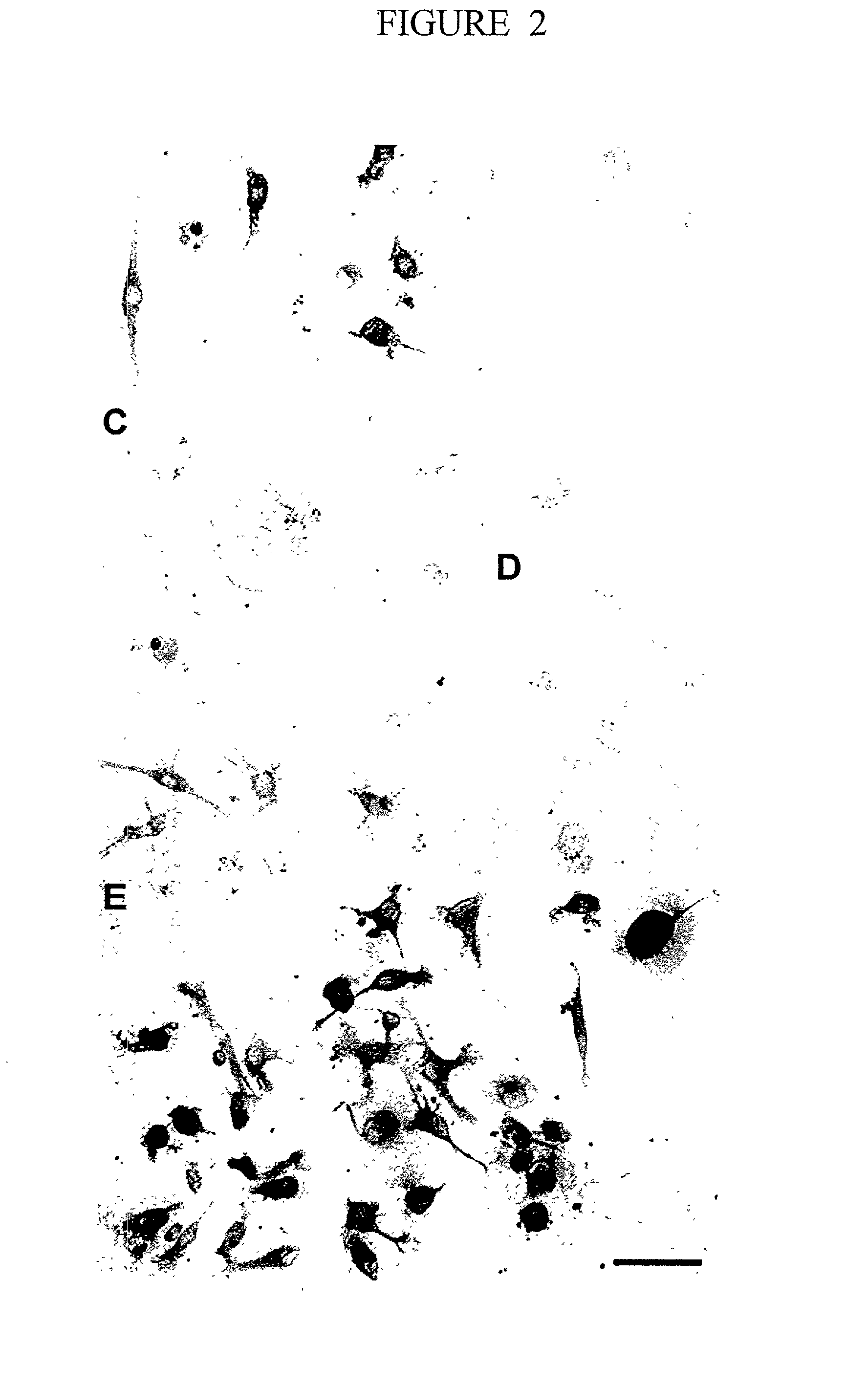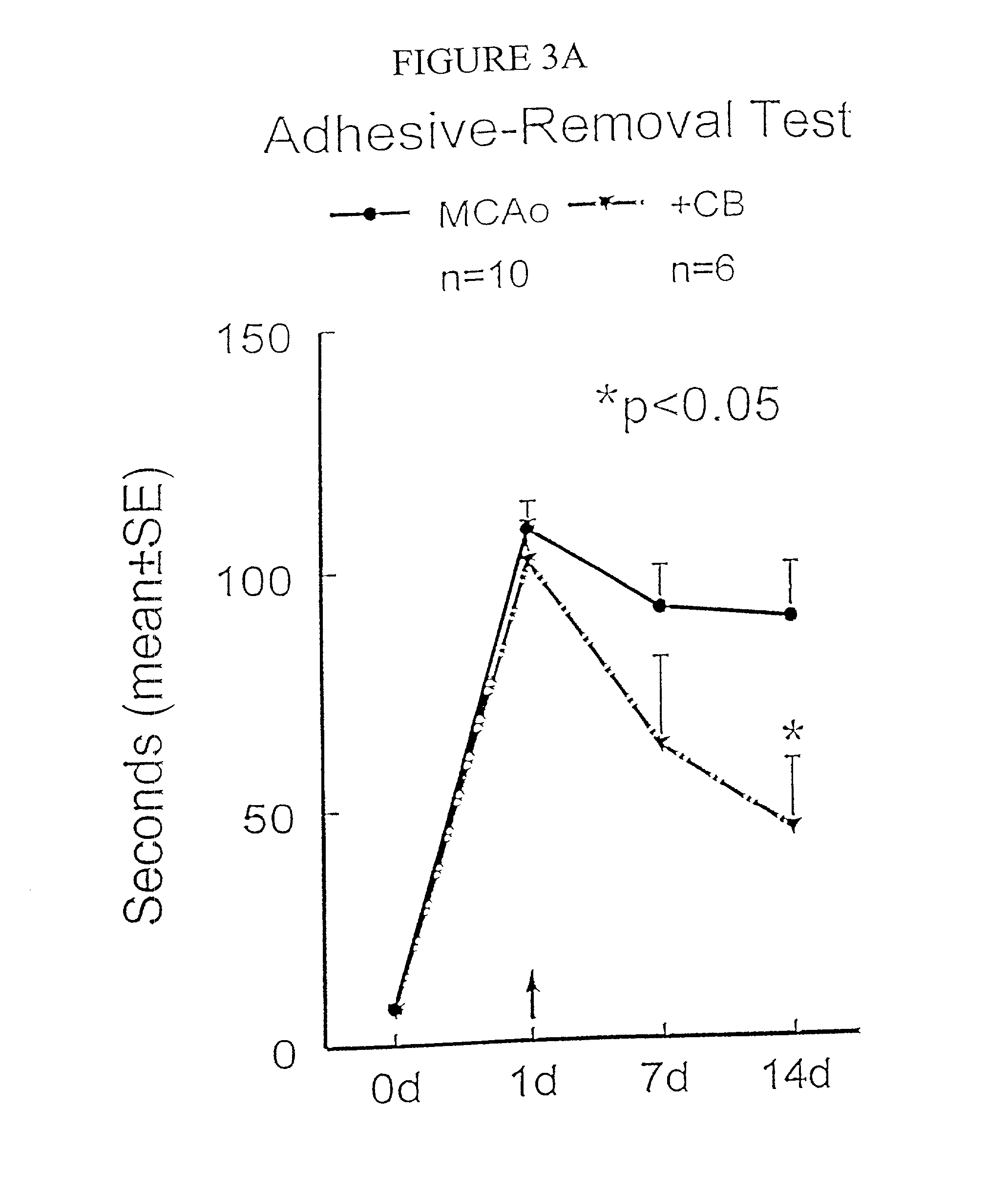[0026] It is an object of the present invention to provide a novel source of pluripotent stem and / or
progenitor cells which can be readily differentiated into neuronal and glial cells to be used in transplantation in the brain and spinal cord of a patient and for the treatment of neurodegenerative diseases.
[0032] The present invention relates to the unexpected discovery that fresh or reconstituted umbilical
cord blood or a mononuclear cellular fraction thereof is a novel source of cells which can be differentiated into neural cells and / or neuronal tissue and used for neuronal transplantation (autografting as well as allografting), thus obviating the need to use pooled neuronal
fetal tissue or
bone marrow tissue, which is often hard to obtain. Thus, the present invention may be used for autografting (cells from an individual are used in that same individual), allografting (cells from one person are used in another person) and xenografting (transplantation from one species to another). In this aspect of the present invention, it has unexpectedly been discovered that umbilical
cord blood from neonates or fetuses comprises cells which may be induced to become neurons
in vitro and
in vivo. These cells may be used in autologous or
allogeneic transplantation (
grafting) procedures to improve
neurological deficit and to effect transplantation and repair of neural / neuronal tissue, in particular, tissue of the brain and spinal cord and to treat neurodegenerative diseases of the brain and spinal cord.
[0036] Alternatively, an enriched
cell population of pluripotent stem and / or
progenitor cells may be obtained from a
population of mononuclear cells obtained from umbilical cord blood by subjecting the mononuclear
population to an amount of an anti-proliferative agent (such as Ara-C [
cytidine arabinoside] or
methotrexate, among others) effective to eliminate all or substantially all proliferating cells and then exposing the remaining non-proliferating cells to a mitogen such as
epidermal growth factor or other mitogen (including other growth factors) to provide a population of differentiated cells and quiescent cells (pluripotent stem or
progenitor cells) which population is grown in culture medium such that the quiescent cells are concentrated in the
cell population to greatly outnumber the differentiated cells. The pluripotent stem and / or progenitor cells obtained may then be grown in a cell medium containing a differentiation agent as generally described above in order to change the
phenotype of the stem and / or progenitor cells to neuronal and / or glial cells which cells may be used in transplantation procedures directly without further purification.
[0060] In a preferred aspect of the present invention, mononuclear cells grown in standard cellular media (preferably, at least a minimum essential medium supplemented with non-essential amino acids,
glutamine, mercaptoethanol and
fetal bovine serum (FBS)) are grown in a "neural proliferation medium" (i.e., a medium which efficiently grows neural cells) followed by growth in a "differentiation medium", generally, which is similar to the neural proliferation medium with the exception that specific nerve
differentiation agents are added to the medium and in certain cases, other growth factors are limited or removed). A particularly preferred neural proliferation medium is a media which contains DMEM / F12 1:1 cell media, supplemented with 0.6% glucose,
insulin (25 .mu.g / ml),
transferrin (100 .mu.g / ml), progesterone 20 nM,
putrescine (60 .mu.M,
selenium chloride 30 nM,
glutamine 2 mM,
sodium bicarbonate 3 mM,
HEPES 5 mM,
heparin 2 ug / ml and EGF 20 nm / ml, bFGF 20 ng / ml. One of ordinary skill will readily recognize that any number of cellular media may be used to grow mononuclear cell fractions of umbilical cord blood or to provide appropriate neural proliferation media and / or differentiation media.
[0065] The term "neurodegenerative disease" is used throughout the specification to describe a disease which is caused by damage to the
central nervous system and which damage can be reduced and / or alleviated through transplantation of neural cells according to the present invention to damaged areas of the brain and / or spinal cord of the patient. Exemplary neurodegenerative diseases which may be treated using the neural cells and methods according to the present invention include for example, Parkinson's disease, Huntington's disease,
amyotrophic lateral sclerosis (Lou Gehrig's disease), Alzheimer's disease,
Rett Syndrome,
lysosomal storage disease ("
white matter disease" or glial / demyelination disease, as described, for example by Folkerth, J. Neuropath. Exp. Neuro., 58, Sep. 9, 1999), including Sanfilippo, Tay Sachs disease (beta
hexosaminidase deficiency), other genetic diseases,
multiple sclerosis, brain injury or trauma caused by
ischemia, accidents, environmental insult, etc., spinal cord damage,
ataxia and alcoholism. In addition, the present invention may be used to reduce and / or eliminate the effects on the
central nervous system of a
stroke or a heart
attack in a patient, which is otherwise caused by lack of
blood flow or
ischemia to
a site in the brain of said patient or which has occurred from physical injury to the brain and / or spinal cord. The term neurodegenerative diseases also includes neurodevelopmental disorders including for example,
autism and related neurological diseases such as
schizophrenia, among numerous others.
 Login to View More
Login to View More  Login to View More
Login to View More 


